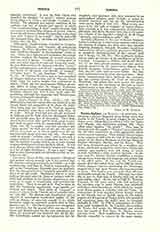

Tonica Indians (OR TUNICA).—A small tribe constituting a distinct linguistic stock living, when first known to the French, in small villages on the lower Yazoo river, Mississippi, in alliance with the Yazoo and Ofogula, and numbering perhaps 700. Their tribal name signifies “the people”. They may be identical with the people of “Tanico”, encountered by the De Soto expedition in 1540, apparently about northeastern Louisiana. Their definite history begins in the summer of 1698 with the visit of the missionary priests of the Quebec Seminary of Foreign Missions, Fathers Montigny, Davion, and La Source. They had been decimated just before by a smallpox epidemic, which had ravaged the whole lower Mississippi country, and numbers were still dying, of whom several, including a chief, received baptism. In the next year Fr. Antoine Davion established a mission among them, studying their language and ministering to the allied tribes. In this year the French commander Iberville visited them, and in 1700 the Jesuit, Father Jacques Gravier, descending the Mississippi, stopped off to wait upon Davion, who was prostrated by fever. The Tonica were noted for their affection and loyalty toward the French. This may have been due in part to their lack of kinship with any of the surrounding tribes. In the fall of 1702 Fr. Nicholas Foucault, of the same order, who had arrived in the previous year to assist Davion, was murdered with three other Frenchmen, while asleep, by treacherous Koroa guides in collusion with the Yazoo. In consequence of these murders Father Davion retired to the French fort at Mobile until, at the urgent request of a delegation of Tonica chiefs, who promised full reparation upon the guilty ones, he returned, probably in 1705. In 1706, in consequence of Chickasaw raids instigated by the Carolina slave-traders, the Tonica fled across the Mississippi and settled near the mouth of Red River, Fr. Davion accompanying them. Their neighbors, the Taensa, were likewise compelled to remove by the same enemy.
In 1719 the historian La Harpe stopped at the Tonica village and found Father Davion still there and “very much revered”, although preaching fearlessly against their polygamy and heathen ceremonials. They had given up their worst heathenisms and the head chief, with his family, was a daily attendant at the sermons. Charlevoix visited their principal town in 1721 and describes the chief, Cahura-Joligo, as devoted to the French, wearing civilized dress, wealthy, and having the full confidence of the commandants. The houses were built around an open space used for games. Father Davion had some time before left them for the last time, in despair at their indifference, and notwithstanding their affection for him, which was not disturbed even when in his zeal on one occasion, he had burned their sacred fire temple.
In the various difficulties with the powerful Natchez, beginning in 1716, the Tonica, almost alone of the Indian tribes, rendered efficient service to the French. In the final war, beginning in 1729, they again supported the French. In retaliation a large body of fugitive Natchez, aided by the Chickasaw and Koroa, fell upon the Tonica (1731) and defeated them in a desperate battle, killing their best warriors and their head chief Cahura-Joligo. They never recovered from this blow. In 1758 they still counted about 250 souls in a village above Pointe Coupée but some time between 1784 and 1803 the remnant removed to the neighborhood of Marksville, Louisiana, on the Red River, where some thirty mixed bloods still remain, besides a few others scattered in the Choctaw Nation, Oklahoma, and elsewhere. In 1886 Dr. Albert Gatschet of the Bureau of American Ethnology collected from the survivors the first recorded vocabulary of the language, by which he was enabled to classify it as constituting a distinct stock. This was supplemented in 1909 by Dr. John R. Swanton, of the same Bureau, who also obtained several interesting myths. The Tonica were an agricultural tribe and in arts, customs and general culture closely resembled their neighbors, the Natchez and Taensa. Both sexes had the head artificially flattened, went nearly naked except on ceremonial occasions, and wore the hair at full length down the back. The men did most of the heavy work, spending most of their time in the corn fields and rarely hunting, so that they ate but little meat. They buried in the ground and kept a light burning, and a watch beside the grave for four nights until the soul was supposed to have reached the spirit world. They had a temple with a sacred fire and according to Father Gravier, had nine principal gods, viz. the Sun, Thunder, Fire and the gods of the four cardinal points, Sky, and Earth. There is no record of the bloody rites characteristic of the Natchez and Taensa.
JAMES MOONEY

